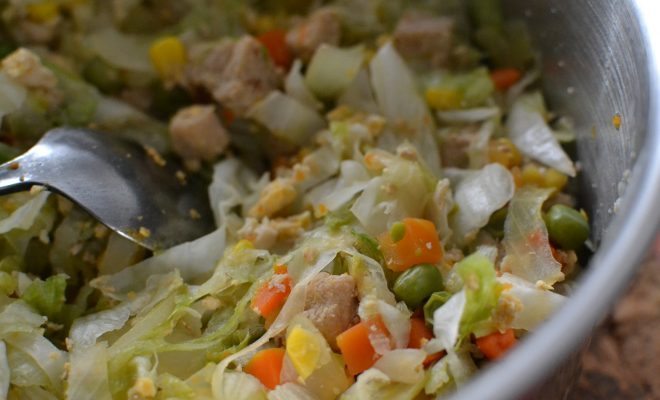 Image courtesy of [kawaiikiri via Flickr]
Image courtesy of [kawaiikiri via Flickr]
Health & Science
Foodie Flavor: The Science Behind Your Favorite Tastes
You just ordered a chargrilled pineapple steak with blue cheese ice cream. If the cost is any indication, it has to taste good. Right?
You take a tentative bite. The flavors mingle on your tongue in an explosion of taste bud pleasure. How do they come up with this stuff?
Some chefs use science to select ingredient pairs that lead to culinary bliss. The odd coupling of pineapple and blue cheese owes its delectable flavor to a compound found in both ingredients: methyl hexanoate. So if you don’t trust your imagination and instincts to prepare food with the reckless elegance of a chef, turn to matching aromatic compounds as a logical guide to selecting ingredients that complement instead of clash.
Here’s your science-based foodie flavor guide.
Getting to Yum
You have it pretty easy when it comes to flavor. You bring a fork to your mouth and experience a burst of flavor instantly. Yum. No thinking. No processing. Meanwhile, your senses work overtime to endow you with the gift of flavor.
When we talk about flavor, we’re talking about the overall sensation that combines smell, taste, temperature, texture, and appearance–the whole delicious bundle of qualities that food delivers to your ravenous senses. While texture and appearance deserve honorable mentions, taste and smell take the flavor trophy. Taste and smell (made possible by the olfactory dream team of nose, mouth, and brain) work together to bring you flavor.
Taste
Your mouth contains a hierarchy of structures that help you taste. You know those bumps you can see on your tongue? They’re not taste buds, they’re called papillae. The papillae contain taste buds, the taste buds contain taste cells, and the taste cells contain even smaller structures called microvilli. And it’s not over yet. The microvilli contain the receptor proteins that tell your brain when you’re tasting something. These little receptors send messages through a network of nerves that ends at the cerebral cortex, which then creates the perception of taste.
We all have about 5,000-10,000 taste buds, but we can only detect five flavors: sweet, salty, bitter, sour, and umami. As the central location for taste, the mouth hogs a lot of credit for flavor. But your underappreciated sense of smell deserves more glory than it receives.
Smell
Your sense of smell helps you perceive flavor more than your sense of taste. Smell works in two ways:
- Orthonasal olfaction: This happens when you inhale and smell. Think of the aroma of fresh baked bread wafting through the cracks in the floorboards.
- Retronasal olfaction: This happens when you already have food in your mouth. Once food gets to your mouth, its aroma vapors creep up the back of your throat and make it to your nose. Chewing food accelerates this process. Retronasal olfaction enables most flavor sensations. Imagine how your food tastes like cardboard when you have a cold. It’s because essential aroma vapors can’t reach your nasal passage.
Your nasal passage is home to millions of receptors. They’re standing at attention to attach to odor molecules and send scent signals to your olfactory bulb, the brain’s odor-processing hub. The olfactory bulb translates the scent signals and relays that information to the piriform cortex, which recognizes the odor and lets you know what it is. As complicated as it seems, this all happens in a flash, enabling you to recognize odors instantly.
Bonus fun fact: the olfactory bulb connects to the limbic system, the part of our brain that deals with emotions. That’s why certain scents spark vivid memories.
What makes a flavor?
Your favorite foods contain hundreds of compounds that work together to create flavor. Compounds in food are generally low per unit, but their synergies bring us the flavors we know and love. Some of the aroma molecules in cacao beans smell separately like cooked cabbage or beef. When they merge with the bean’s other molecules and a few key ingredients, they present the flavor of chocolate.
Aroma compounds and taste compounds work together to bring you the impression of flavor. Nonvolatile taste compounds only react with receptors when they dissolve in your mouth, so their range of detection is limited to the five kinds of taste. Volatile aroma compounds become gas at room temperature and reach nasal passage receptors via inhalation. Your nasal odor receptors help your brain detect thousands of different aromas–just one of the ways aroma compounds and our sense of smell bring flavors to life.
Are compounds the key to perfect flavor?
With the number of ingredients at our disposal, our recipes could be infinite. Yet we always return to the same key ingredients and steadfast combinations. Researchers Yong-Yeol Ahn and Sebastian E. Ahnert set out to discover a scientific reason for this inclination.
They explored the world of taste and aromatic compounds to find out why some foods taste wonderful together and end up in recipes while others fade to obscurity. They based their research around a long-standing culinary hypothesis: ingredients that share flavor compounds will taste the best together.
The researchers created a flavor network of ingredients that share compounds. They used over 50,000 recipes to perform their analysis and split cuisines into geographic subgroups to account for cultural disparity.
They found that North American and Western European palettes favor ingredients that share compounds–the more shared compounds, the better. One of the most common compound-sharing triads in North American and Western European cuisine is butter, egg, and vanilla.
In contrast, East Asian and Southern European recipes prefer ingredients without matching compounds. East Asian recipes often feature scallions, sesame oil, and soy sauce–ingredients with no matching compounds.
What does that mean for your cooking?
If you’re really serious about compound-based food pairing and don’t happen to have the equipment to detect aromatic matches in your ingredients, you have other options. You could use the flavor network we already discussed or a website like foodpairing.com, which helps you find ingredients with aromatic-compound matches. According to the site, these ingredients have compound matches:
- Bacon, cranberries, olive oil, chicken, buffalo mozzarella, and strawberries
- Peanuts and Cointreau
- Avocado, tomato, banana, carrot, and rosemary
- Werthers hard candy and beef (seriously)
- Carrot, cilantro, rosemary, and raspberry
- Graham cracker, strawberry, and beef (this might make an interesting pie if you’re feeling adventurous)
When someone doesn’t like your food…
Sadly, you can’t win them all. Some people might not be able to handle your culinary food pairing prowess. Even if you follow compound matching, human preferences remain tenuous, unpredictable, and far from universal.
Here are some reasons why people have different flavor preferences (a.k.a why they’re wrong):
- Many flavor preferences form in infancy: In the first months of life, what the mother eats will be passed through breast milk and influence preferences for life. Bottle feeding takes some of this sensory learning away. If babies are repetitively exposed to the same boring flavors, they might learn to love bland food.
- Some people have more sensitive flavor receptors: Some people have a receptor gene, 6-n-Propylthiouracil (PROP), that makes them especially sensitive to bitter flavors. They’re often called supertasters. Supertasters typically have more papillae on the tongue and feel everything on the tongue more strongly, including pain. The discovery of the receptor gene confirms that flavor preference cannot be universal.
- They might be fooled by appearances: What a food looks like has a huge impact on the flavor you’re expecting. If you’re always taking a gulp of root beer and expecting Coke, you might learn to hate root beer on account of unpleasant surprise.
Beyond all of this, food preferences can be environmental and psychological as well. Positive scent associations, childhood memories, and more can stack the cards for or against different foods. But just remember, it’s not you, it’s them.
True Flavor Appreciation
Going out to dinner in the near future? Keep an eye out for ingredients in your favorite dishes and look them up to see if they have any compound matches. There might be a science behind your preferences.
But mostly remember that even the simplest bite of food is a magical experience. The minute it hits your lips, thousands of compounds trigger a frenzy of processes that course through your nerves on their way to the brain. Thousands of compounds and thousands of internal reactions enable you to say yum or yuck. Even if you don’t like what you’re eating, you can appreciate the process that allowed you to experience its flavor. Now that’s appreciating food.
Bon appetit!
Resources
Primary
American Chemical Society: Flavor Chemistry Research at the USDA Western Regional Research Center
Additional
Nature: Flavor Network and the Principles of Food Pairing
Prepared Foods: Altered Senses
Food Processing: Fighting Palate Fatigue
Prepared Foods: Focus on Flavor
Accidental Scientist: Experiencing Flavor
Science of Cooking: What is Flavor?
Food Navigator: The Science Behind Food Pairing
Bon Appetit: The Science Behind Our Seemingly Weird Food Combinations
Science of Cooking: The Molecular Basis For Taste
Bon Appetit: The Senses – A Primer







Comments